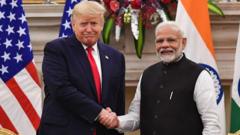With tariffs and protectionist policies, the U.S. attempts to revive its semiconductor industry, but experts caution about the complexities and long-term investment required against established Asian powerhouses like Taiwan and China.
The Challenges of Reviving U.S. Semiconductor Manufacturing Amid Global Competition

The Challenges of Reviving U.S. Semiconductor Manufacturing Amid Global Competition
The U.S. faces significant hurdles in reclaiming leadership in semiconductor production as rival nations advance.
The semiconductor landscape presents a complex challenge for the U.S., as officials highlight the nation's stalled progress in chip manufacturing while Asia accelerates forward. In a notable 2021 interview, then Commerce Secretary Gina Raimondo indicated that the U.S. has "dropped the ball" in this crucial technology sector. Fast forward to today, it remains a battleground in the ongoing competition for tech supremacy between the United States and China, with former President Donald Trump advocating for an aggressive strategy to boost domestic production.
Trump's proposed tariff policy aims to revitalize the U.S. economy and create jobs, yet it raises concerns among industry leaders who warn about existing problems, including a shortage of skilled labor and substandard domestic output. Experts question whether Trump’s administration can successfully emulate the intricate and sophisticated manufacturing processes perfected in Asia.
Semiconductors drive an extensive array of technology, from everyday appliances to military applications. Although the U.S. pioneered the invention of microchips, countries within Asia have emerged as dominant players in their production. The manufacturing of these chips is costly and technologically demanding, involving a convoluted supply chain where designs may originate in the U.S., but production often takes place in Taiwan, Japan, or South Korea, among others.
Recently, Trump has leveraged tariffs as a means to pressure companies like the Taiwan Semiconductor Manufacturing Company (TSMC) to build operations in the U.S. However, given the industry's complexity and the stiff competition, effective long-term planning remains elusive under such unpredictable policies. Companies are slowly responding to Trump's calls to invest domestically, aided by substantial government incentives through the U.S. Chips and Science Act, enacted in 2022.
Despite these attempts, challenges persist. TSMC and Samsung report complications in establishing facilities in the U.S., including rising costs and difficulties in hiring skilled workers. While TSMC's factories in Arizona start producing chips, many of their high-tech activities remain centered in Taiwan, which continues to lead in advanced chip manufacturing capabilities.
The geopolitical landscape has also influenced the dynamics of chip production, especially as concerns mount over potential Chinese threats to Taiwan. Investors are now casting new eyes towards countries like India, which, with its inexpensive labor and commitment to fostering chip manufacturing, poses as a possible emerging hub, albeit with its own set of obstacles.
While tariffs attempt to reshape the landscape in favor of U.S. firms, the need for collaboration rather than isolation may be crucial to rebuilding a sustainable semiconductor industry. Major American corporations depend heavily on these chips, which may incentivize negotiation rather than confrontation over tariffs. The ongoing adjustments to U.S. policies – whether accommodating lobbying efforts from tech giants or examining immigration bottlenecks for foreign talent – will prove vital for realigning America's semiconductor ambitions on a global stage.






















